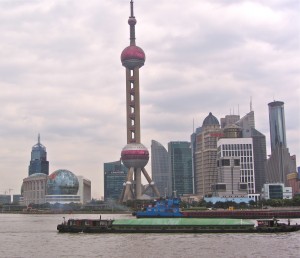SHANGHAI, CHINA, OCTOBER 28, 2011: When I arrived in Shanghai mainland China, I was jolted into the realization that everything seems to be on a higher order of magnitude. The terms “largest in the World” “World’s first…, etc.” seem to apply to a lot of things in China.
Shanghai’s Pudong International Airport is humongous – you walk for hundreds of yards just to get through immigration and reach the Maglev Train to take you to the city.
The Maglev train is the World’s first commercial train to not have wheels or use rails. Created by Germany’s Siemens, this incredible train rides on magnetic levitation to suspend and propel itself. The train is the World’s fastest, reaching speeds of 360+ mph which surpasses France’s TGV and Japan’s Bullet Train both of which I have adventured on. During my 20+ minutes to the city, the ride was much quieter than a normal train ride. Over the car doors, they have a digital update of the train’s speed – we hit 286 mph!
In the last two decades, Shanghai has grown at a phenomenal rate. It sits on the Huangpu River, a branch of the lower reaches of the Yangtze River. Shanghai is reputed to be China’s biggest city by population with more that 24+ million people (Chongqing municipality with 28+ million disputes this). It has the largest city proper in the World along with the World’s largest container port. For China, the City serves a critical role as a financial, transport, media and technological center. Right now, Shanghai is getting over its hang over of hosting Expo 2010 Shanghai where millions of people/tourists piled into the city from all over the World.
When I arrived in downtown Shanghai, a light haze clung over the city. I was told this is normal and really a form of smog created by car, industrial emissions. I explored a historical neighborhood along the Huangpu riverbank called the Bund where the commercial interests of the colonial powers used to operate out of. The Huangpu was packed with commercial traffic of every nature.
Off of the Bund, is a phenomenally large shopping area where every global company is selling its goods/wears to the ever expanding prosperous Chinese upper/middle urban classes. The place is overrun with shoppers who, incredibly, can afford the “high end” items which a lot of Americans now cannot afford.
In leaving Shanghai, I decided to test China’s high speed rail system on my trip to Beijing. Once again, China is reputed to have the World’s largest high speed rail network. The rail system was intended to emulate Japan’s. The Shanghai to Beijing run goes 800+ miles in 5 hours at at 190+ mph. This all sounds great but the train had a massive wreck a couple of months ago where many were killed – it appears the Chinese may be building their system too fast.
Another short coming of the Shanghai to Beijing run is that it is difficult getting to the train in the first place. Instead of conveniently leaving from the Shanghai’s city’s center, the Beijing train leaves from Hongqiao Railway Station which is a way from the city’s center. So after a 40 minute harrowing cab ride, I reached the Hongqiao terminal and, needless to say, the terminal was gigantic. It is the largest in Asia – what a surprise! All the trains in the terminal appeared to be new as opposed to America’s aging railway stock.
In reflection, Shanghai and, indeed China” have become “too big to fail”.
PS: I had hoped to provide links to YouTube videos covering some of the items I just discussed but, alas, China does not permit internet access to YouTube so I will post my videos when I reach Japan in several days.


